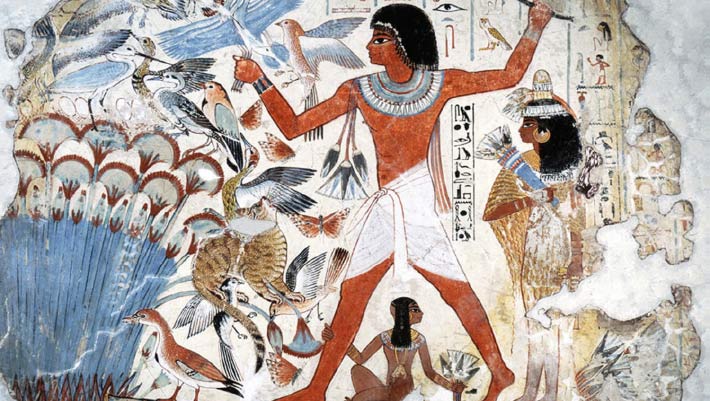An international team of scientists has sequenced the whole genome from an adult male Egyptian who lived between over 4,500 years ago — a few centuries after Egyptian unification, bridging the Early Dynastic and Old Kingdom periods.

Nebamun hunting in the marshes with his wife and daughter, part of a wall painting from the tomb-chapel of Nebamun, Thebes, New Kingdom, 1350 BC. Image credit: Werner Forman Archive / Bridgeman Images.
“Forty years have passed since the early pioneering attempts to retrieve DNA from mummies without successful sequencing of an ancient Egyptian genome,” said co-senior author Dr. Pontus Skoglund, a researcher at the Francis Crick Institute.
“Ancient Egypt is a place of extraordinary written history and archaeology, but challenging DNA preservation has meant that no genomic record of ancestry in early Egypt has been available for comparison.”
“Building on this past research, new and powerful genetic techniques have allowed us to cross these technical boundaries and rule out contaminating DNA, providing the first genetic evidence for potential movements of people in Egypt at this time.”
In the study, the researchers extracted and sequenced DNA from the tooth of an individual from Nuwayrat, a village 265 km south of Cairo.
By analyzing his genetic code, they showed that most of his ancestry mapped to ancient individuals who lived in North Africa.
The remaining 20% of his ancestry could be traced to ancient individuals who lived in the Fertile Crescent, particularly an area called Mesopotamia (roughly modern-day Iraq).
This finding is genetic evidence that people moved into Egypt and mixed with local populations at this time, which was previously only visible in archaeological artifacts.
However, the scientists caution that many more individual genome sequences would be needed to fully understand variation in ancestry in Egypt at the time.
By investigating chemical signals in his teeth relating to diet and environment, they showed that the individual had likely grown up in Egypt.
They then used evidence from his skeleton to estimate sex, age, height, and information on ancestry and lifestyle.
These signs suggested he could have worked as a potter or in a trade requiring comparable movements, as his bones had muscle markings from sitting for long periods with outstretched limbs.
“Piecing together all the clues from this individual’s DNA, bones and teeth have allowed us to build a comprehensive picture,” said first author Dr. Adeline Morez Jacobs, a researcher at Liverpool John Moores University.
“We hope that future DNA samples from ancient Egypt can expand on when precisely this movement from West Asia started.”
“This individual has been on an extraordinary journey,” said co-senior author Dr. Linus Girdland Flink, also from Liverpool John Moores University.
“He lived and died during a critical period of change in ancient Egypt, and his skeleton was excavated in 1902 and donated to World Museum Liverpool, where it then survived bombings during the Blitz that destroyed most of the human remains in their collection.”
“We’ve now been able to tell part of the individual’s story, finding that some of his ancestry came from the Fertile Crescent, highlighting mixture between groups at this time.”
“The markings on the skeleton are clues to the individual’s life and lifestyle — his seat bones are expanded in size, his arms showed evidence of extensive movement back and forth, and there’s substantial arthritis in just the right foot,” said Liverpool John Moores University’s Professor Joel Irish, co-author of the study.
“Though circumstantial these clues point towards pottery, including use of a pottery wheel, which arrived in Egypt around the same time.”
“That said, his higher-class burial is not expected for a potter, who would not normally receive such treatment.”
“Perhaps he was exceptionally skilled or successful to advance his social status.”
The study was published in the journal Nature.
_____
A. Morez Jacobs et al. Whole-genome ancestry of an Old Kingdom Egyptian. Nature, published July 2, 2025; doi: 10.1038/s41586-025-09195-5
























